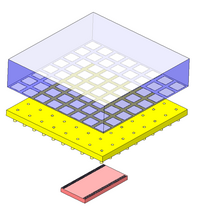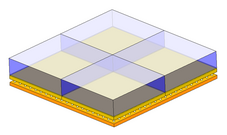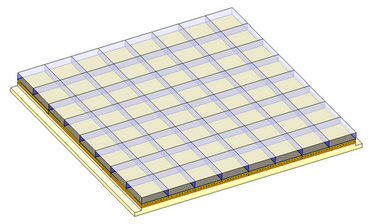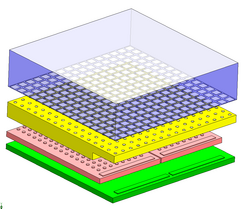|
CZT & ASIC development
1. ProtoEXIST1
The principal technology challenge is the development of the very
large array of CZT imaging detectors. The small pixels on a single CZT
crystal allow more efficient detector and readout connections to a single
multi-pixel readout ASIC (application specific integrated circuit), which
provides charge preamp, shaping and peak detect on each pixel above a
programmable threshold.
The CZT-ASIC readout must allow for an inter-connect and packaging
system that permits tiling of the CZT-ASIC modules in a semi-infinite
detector plane without (significant) gaps to achieve maximum packing
efficiency without dead spaces on a motherboard for interface to a
digital data system.
 Over the past year of our current SRT program, we have carried out an
extensive test program for the detector and RADNET ASIC module for
the prototype module of 2 x 2 CZT crystals and ASICS for
ProtoEXIST1.
Over the past year of our current SRT program, we have carried out an
extensive test program for the detector and RADNET ASIC module for
the prototype module of 2 x 2 CZT crystals and ASICS for
ProtoEXIST1.
 Many of the features of this ASIC (approximate gain, and particularly
its multi-pixel readout capability) are appropriate for ProtoEXIST1.
Thus, we employ the RADNET detector packaging architecture
to be fundamental detector module - a Detector
Crystal Module (DCM) consisting of a 20 x 20 x 5mm CZT crystal with 8
x 8 pixel anodes connected through an Interposer Board (IPB) to the
ASIC underneath the IPB. The figure shows views of the DCM (yellow - IPB
and pink - RADNET ASIC), and the photo shows the actual modules.
Many of the features of this ASIC (approximate gain, and particularly
its multi-pixel readout capability) are appropriate for ProtoEXIST1.
Thus, we employ the RADNET detector packaging architecture
to be fundamental detector module - a Detector
Crystal Module (DCM) consisting of a 20 x 20 x 5mm CZT crystal with 8
x 8 pixel anodes connected through an Interposer Board (IPB) to the
ASIC underneath the IPB. The figure shows views of the DCM (yellow - IPB
and pink - RADNET ASIC), and the photo shows the actual modules.
 This has been in close collaboration with LLNL and
Caltech, who have developed a 64 channel ASIC derived from the
Caltech-HEFT design (Cook et al 1998) that was optimized for higher
energy range (~100-1000 keV) for Homeland Security application as a
cellphone-based radiation detector (RADNET).
The DCM mounts to a motherboard via a pingrid
array and 4 such DCMs will be mounted to a
common Detector Crystal Array (DCA) board containing the FPGA to
control and readout the 4 ASICs.
We combine 4 x 4 DCAs onto a Detector Module (DM,
256 cm2) and 4 DMs complete the detector plane
(10242cm) for ProtoEXIST1.
This has been in close collaboration with LLNL and
Caltech, who have developed a 64 channel ASIC derived from the
Caltech-HEFT design (Cook et al 1998) that was optimized for higher
energy range (~100-1000 keV) for Homeland Security application as a
cellphone-based radiation detector (RADNET).
The DCM mounts to a motherboard via a pingrid
array and 4 such DCMs will be mounted to a
common Detector Crystal Array (DCA) board containing the FPGA to
control and readout the 4 ASICs.
We combine 4 x 4 DCAs onto a Detector Module (DM,
256 cm2) and 4 DMs complete the detector plane
(10242cm) for ProtoEXIST1.

2. ProtoEXIST2
 The desired 5' resolution for the primary high energy
telescopes on EXIST, and the constraints on mask-detector focal length
as 1.5m, require 1.25mm pixels for Nyquist sampling of the mask
shadow. Thus the transition to ProtoEXIST2 is a factor of 2
reduction in CZT pixel size and corresponding factor of 4 in ASIC
pixel number and corresponding increased complexity of connecting the
ASIC to the CZT through the IPB. The desired smaller pixels are more
subject to charge spreading, especially at higher energies, so
multipixel events are more likely. Hence the need for a higher
resolution, multipixel (at least peak plus neighbors, but commandable)
CZT-ASIC combination.
Significant work has already been done on the design concept for this
ASIC during our current SRT grant. However, final layout of this ASIC has
not yet begun due to uncertainty about the best way to couple the ASIC
to the CZT: either with an IPB (as for RADNET and ProtoEXIST1) or with
direct-bonding as for HEFT. The figure shows packaging conceprt using
an IPB for "de-magnification" of pixel pitch from the CZT (1.25mm pitch)
to an ASIC array input (0.9 mm pitch).
The desired 5' resolution for the primary high energy
telescopes on EXIST, and the constraints on mask-detector focal length
as 1.5m, require 1.25mm pixels for Nyquist sampling of the mask
shadow. Thus the transition to ProtoEXIST2 is a factor of 2
reduction in CZT pixel size and corresponding factor of 4 in ASIC
pixel number and corresponding increased complexity of connecting the
ASIC to the CZT through the IPB. The desired smaller pixels are more
subject to charge spreading, especially at higher energies, so
multipixel events are more likely. Hence the need for a higher
resolution, multipixel (at least peak plus neighbors, but commandable)
CZT-ASIC combination.
Significant work has already been done on the design concept for this
ASIC during our current SRT grant. However, final layout of this ASIC has
not yet begun due to uncertainty about the best way to couple the ASIC
to the CZT: either with an IPB (as for RADNET and ProtoEXIST1) or with
direct-bonding as for HEFT. The figure shows packaging conceprt using
an IPB for "de-magnification" of pixel pitch from the CZT (1.25mm pitch)
to an ASIC array input (0.9 mm pitch).
|

